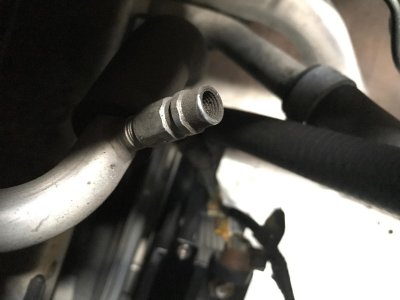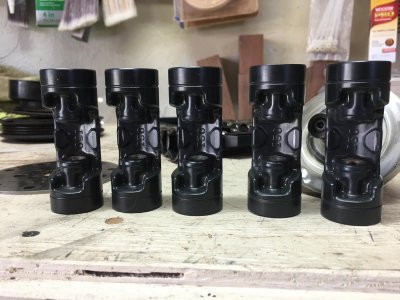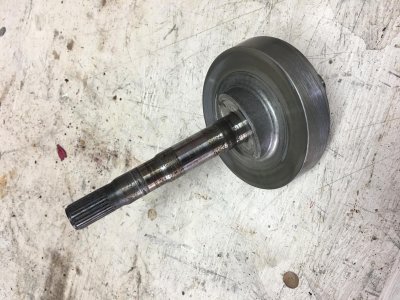Hi, MrHugo.
Probably too late and while your questions were not necessarily directed to me, in the future, if you need someone's attention, please use the 'mention' feature by adding @ marking in front of the userID so that your post have better chance of being noticed.
For example, @
MrHugo
Or, just send PM/email to the user.
I'm based in UK and mainly focusing on the blog on NSXCB site and browse Prime only through tapatalk so may not notice the new post or not quick to respond.
Your photo is showing the R134a retrofit adaptor over the old R12 charge valve.
R12 charge port has fitting with external thread.
R134a one uses quick coupler so there is a hollow section for the coupler to engage.
The internal thread is purely for the sealing cap.
So, your system was converted to R134a in the past.
I'm afraid from your photo, it looks as if the refrigerant and the oil are leaking from there.
The Schrader valve is one of the common place for the leakage issue.
I don't know how the conversion was done (retrofit kit containing just the valve adaptors and the PAG/POA oil, retrofit kit + new compressor or retrofit kit + new compressor + other parts replaced) so I'll only touch on the basic.
There are many early model NSX in Japan and US with their a/c converted to R134a from R12.
If the system is working fine, you would get freezing cold air from the air vent even after the conversion to R134a.
The summer in Japan is really humid and normally over 30degC (86degF).
In August, quite often, it will hit over 35degC (95degF) and from time to time, even 40degC (104degF) yet I have never heard of NSX owners going back to R12 because that's more efficient than the R134a.
There are people staying with R12 for that reason but it's simply because their R12 system is still working.
You don't want driving a car without A/C in Japan…..
It was 37degC (99 degF) today in Tokyo….
I think you are trying to fix your issue from somewhat different/wrong aspect.
So, not necessarily answering your questions but my personal view is as follows towards your question;
1. Re-charge with R12 or 134a?
As you mentioned at the very beginning of your post that your a/c system is not cold enough
anymore, it suggests that it was fine in the past.
Therefore, you need to find the cause of the issue first.
You will end up with the same situation (issue) even if you recharge the system regardless of R12 or R134a.
If it was already converted to the latter, I would stick with it although I don't know how far the conversion was done.
2. If back to R12, what needs to be done?
Your R134a system would be using PAG or POE oil at the moment.
I won't go into detail but if you really want going back to R12 with mineral oil, I recommend disconnecting the compressor and drain any oil left inside and flushing the entire system though some people will tell you that it would be fine without doing these tasks especially if POE is in use.
If you have any leakage, please note that R134a + PAG + moisture is a perfect mixture for creating acid causing corrosion inside the a/c system.
Although compatible, mixing POE and the mineral oil may result in chemical reaction producing another debris causing blockage especially at the exp valve, drier, etc.
Flushing will remove the guess work of how much mineral oil to be poured if going back to R12 although some people would skip the flushing and just drain the remaining PAG/POE oil from the compressor as much as possible.
You must replace the drier any way because of trapped debris, moisture, PAG/POE oil, etc. R134a drier will absorb moisture very quickly.
You will need to remove the retrofit adaptor from the original R12 charge valves.
Make sure to replace the Schrader valve at the same time although you could be forced to do so any way depending on the type of retrofit adaptor.
3. Flush it?
As mentioned above, I recommend flushing it if you really want going back to R12.
It also depends on how the previous conversion was done and the type of oil used.
However, it may not be cost effective to go back to R12.
As you are/were taking the car to the a/c specialist, I'll leave the detail to them but you will need to consider the type of oil used at the time of retrofit (PAG or POE, I'll leave the viscosity in this discussion but very important for the compressor) and also the mineral oil left inside the system before the conversion.
4. AOB?
I would leave it to your a/c specialist.
They will first inspect the health of your existing system and then recommend you what to be done based on your budget level.
Any a/c services could result from quick and easy fix to mega expensive one especially on our NSX due to the length of the system line, parts cost, layout and evaporator being inside the heater unit.
Kaz








